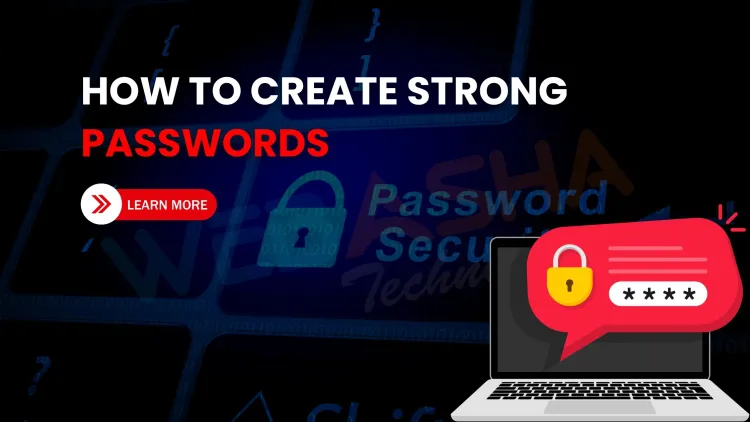How to Create Strong Passwords Without Losing Your Mind | A Step-by-Step Guide
Learn how to create strong, secure, and memorable passwords with ease. This guide covers password best practices, examples, tips, and tools to protect your online identity in 2025.

Table of Contents
- Introduction: Why Strong Passwords Matter
- What Makes a Password “Strong”?
- Step-by-Step: How to Create Strong Passwords (That You Can Actually Remember)
- Advanced Tips for Power Users
- How Hackers Crack Weak Passwords
- Strong Password Checklist
- Real-Life Example: A Password Makeover
- Conclusion
- Frequently Asked Questions (FAQs)
Introduction: Why Strong Passwords Matter
In a world where cyberattacks are rising daily, a weak password is like an open door to your personal and professional life. From bank accounts to email to social media, everything depends on a few secret characters. Yet, creating and remembering strong passwords often feels like an impossible task—unless you know the right strategies.
This blog will help you learn how to create strong, memorable passwords without going crazy, using proven techniques, tools, and best practices.
What Makes a Password “Strong”?
A strong password typically meets the following criteria:
-
Length: At least 12–16 characters
-
Complexity: Includes upper and lowercase letters, numbers, and symbols
-
Unpredictability: Avoids dictionary words, birthdays, or common sequences
-
Uniqueness: Is different for every account
Weak password examples:
-
123456
-
password
-
qwerty
-
john1990
Strong password example:
-
T!m3To#Cl!mb^M0unta!ns2025
Step-by-Step: How to Create Strong Passwords (That You Can Actually Remember)
Step 1: Use a Passphrase, Not a Password
Passphrases are easier to remember and often more secure.
✅ Example:
Instead of L9@x2#tR, try:
MyCoffeeMugIsRed!2025
This sentence-like password is long, memorable, and complex.
Step 2: Turn Phrases into Patterns
Use a memorable phrase and swap some characters for symbols or numbers.
✅ “I love to read books at night”
Becomes:
ILuv2ReadBkz@Nite
This method keeps things personal and familiar.
Step 3: Use Mnemonics
Create passwords based on the first letters of a sentence.
✅ “Every Friday I order two pizzas with extra cheese”
Becomes:
EFIo2PwEC!
It’s unique, memorable, and complex.
Step 4: Avoid Predictable Patterns
Don’t use:
-
Your name
-
Your pet’s name
-
Birthdays
-
Common patterns like
abc123,admin,password
Instead, try combining words from different contexts.
✅ Bad: Sandy123
✅ Good: Gr33nF1sh^Dances99
Step 5: Use a Password Manager
Still struggling? Let a password manager do the heavy lifting:
-
LastPass
-
Bitwarden
-
Dashlane
-
1Password
These tools generate and store ultra-secure passwords for every site.
Advanced Tips for Power Users
Tip 1: Use 2FA Everywhere
Even the strongest password can be compromised. Always enable two-factor authentication (2FA) on all accounts.
Tip 2: Rotate Important Passwords Periodically
Change passwords every 6–12 months, especially for:
-
Email
-
Banking
-
Work accounts
Tip 3: Don’t Reuse Passwords
If one account gets breached, reusing the same password puts all others at risk.
How Hackers Crack Weak Passwords
Here’s how easily weak passwords can be cracked:
| Password Type | Estimated Crack Time |
|---|---|
123456 |
Instant |
password |
Instant |
MyDog2023 |
A few seconds |
Tr0ub4dor&3 |
3 days |
!Rocket^Lunch2025 |
34 years (estimated) |
Strong Password Checklist
✅ At least 12–16 characters
✅ Includes upper & lowercase letters
✅ Uses numbers & symbols
✅ Doesn’t use personal info
✅ Unique for each account
✅ Stored in a password manager
✅ Protected by 2FA
Real-Life Example: A Password Makeover
Old Password: Samantha01
Problems: Easy to guess, uses name, birth year
New Password (Passphrase): SkyDances@Midnight$23
Why it's better: Complex, long, personalized but not predictable
Conclusion: Security Doesn’t Have to Be Stressful
Creating strong passwords doesn’t have to be a nightmare. With a few smart strategies like using passphrases, avoiding predictability, and using a password manager, you can protect your digital life with minimal effort.
Remember: One strong password can save you from countless hours of regret.
FAQs
What is the best way to create a strong password?
The best way to create a strong password is by using a long passphrase that includes uppercase and lowercase letters, numbers, and symbols. Avoid using personal information or common patterns.
How long should a strong password be?
A strong password should be at least 12–16 characters long to resist brute-force attacks and increase overall security.
What is a passphrase in cybersecurity?
A passphrase is a sequence of words or a sentence used as a password. It’s easier to remember and more secure due to its length and complexity.
Should I use the same password for all accounts?
No. Using the same password for multiple accounts is highly risky. If one account is compromised, all linked accounts become vulnerable.
How can I remember strong passwords easily?
You can remember strong passwords by creating a meaningful sentence or passphrase and applying a predictable transformation pattern, such as substituting letters with symbols.
What is the safest way to store passwords?
Using a reputable password manager like Bitwarden, 1Password, or Dashlane is the safest and most convenient way to store and manage your passwords.
Can I write down my passwords on paper?
While writing passwords on paper is better than storing them in a text file, it’s still risky. Always store them in a secure and private place if you choose to write them down.
Are password managers safe to use?
Yes, most modern password managers use strong encryption to protect your data. They are considered one of the best tools for maintaining password security.
What makes a password vulnerable to hacking?
Passwords that are short, common, or use personal information are highly vulnerable to brute-force, dictionary, and social engineering attacks.
How often should I change my passwords?
It's recommended to change passwords for important accounts like email and banking every 6 to 12 months or immediately if a breach is suspected.














![Top 10 Ethical Hackers in the World [2025]](https://www.webasha.com/blog/uploads/images/202408/image_100x75_66c2f983c207b.webp)








